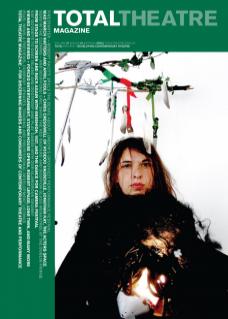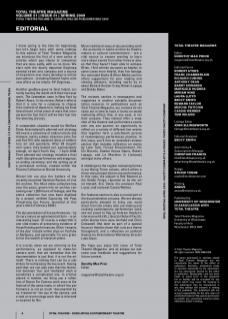I know spring is the time for beginnings, but let’s begin here with some endings. In this edition of Total Theatre Magazine we introduce the first of a new series of articles which pay tribute to companies that are now, sadly, with us no more. We start with the dearly departed Dogtroep, seminal street arts company and a source of inspiration over many decades to artists everywhere – including Edward Taylor, who now offers us his tribute. RIP Dogtroep...
Another goodbye goes to Goat Island, currently touring the world with their last ever work, The Lastmaker, seen in New York by Robert Ayers. In his review, Robert reflects that it is rare for a company to choose their moment of departure, making (as Goat Island have) a final piece of work that incorporates the fact that it will be their last into the devising process.
A comparable situation would be Welfare State International’s planned exit strategy. WSI were a collective of radical artists and thinkers, led by artistic directors John Fox and Sue Gill, who explored ideas of celebratory art and spectacle. After 38 magnificent years, they bowed out, appropriately enough, on April Fool’s Day – 1 April 2006. Their planned exit strategy included a final multi-discipline performance extravaganza; an ending ceremony; and the setting up of a permanent archive, created within the Theatre Collection at Bristol University.
Bristol Uni are also the holders of the recently launched National Review of Live Art archive. The NRLA video collection has, over the years, grown into an archive containing over 1,200 hours of footage, and the entire collection has now been digitised by a project entitled Capturing the Past, Preserving the Future, launched at this year’s NRLA (February 2009).
The documentation of live performance – by its very nature an ephemeral artform – is an interesting topic. Of course a video/DVD is one vital means of preserving evidence of those fleeting performances. Other ‘remains of the day’ include online clips on YouTube or MySpace, and personally I’m very grateful for the wealth of material online.
It is crucial, when we are referring to live performance, as opposed to made-for-camera work, that we remember that the documentation is just that; it is not the art itself. There is nothing that can be a substitute for witnessing the live event. Having said that, we can also note that the distinction between ‘live’ and ‘mediated’ work is sometimes a complicated one. In articles placed in tandem, we bring you a reflection of Dance For Camera work seen at the festival of the same name, in which live performance is not so much ‘documented by’ as ‘created for’ the eye of the camera; and a look at recent stage work that is informed or inspired by film.
More traditional ways of documenting work – the accounts in books written by theatre-makers or cultural commentators – are a vital source to anyone wanting to learn more about events from other times or places that they haven’t been able to witness. Often, I find written accounts as helpful, in some cases more helpful, than live footage. Our extended Books & Other Media section offers suggestions for your reading and viewing pleasure, including works by or about Edward Gordon-Craig, Robert Lepage, and Bobby Baker.
The reviews section in newspapers and magazines is another valuable documentation resource. In publications such as Total Theatre Magazine, our reviews do not come out in time to have a ‘bums-on-seats’ marketing effect; that, in any case, is not their purpose. They instead offer a snapshot of the theatre and performance scene over any one quarter; an opportunity to reflect on a variety of different live events that together form a patchwork picture of contemporary performance practice. In this issue, you’ll find an extended reviews section that includes reflection on works by Lone Twin, Forced Entertainment, Chi Chi Bunichi, Station House Opera, Robert Lepage, and La Machine in Liverpool, amongst many others.
A challenge to the regular reviewing format is our Being There column, which offers a three-way perspective on one performance. In this case, the subject is Red Bastard at the Dublin Fringe, reported on by the artist himself, Eric Davis; his producer Paul Lucas; and reviewer Cassie Werber.
Our features section is also a crucial part of the documentation process. We are always particularly pleased to bring you word direct from the artists who are making and curating contemporary performance work, and are proud to flag up Andrew Haydon’s interview with SPILL director Robert Pacitti; artist diaries from Jane Arnfield and Chris Cresswell (the later as part of a special focus on theatre clown that runs as a theme throughout); and a reflection on political theatre by International Workshop director Luke Dixon.
We hope you enjoy this issue of Total Theatre Magazine, and as always we welcome your feedback and suggestions for future content.

